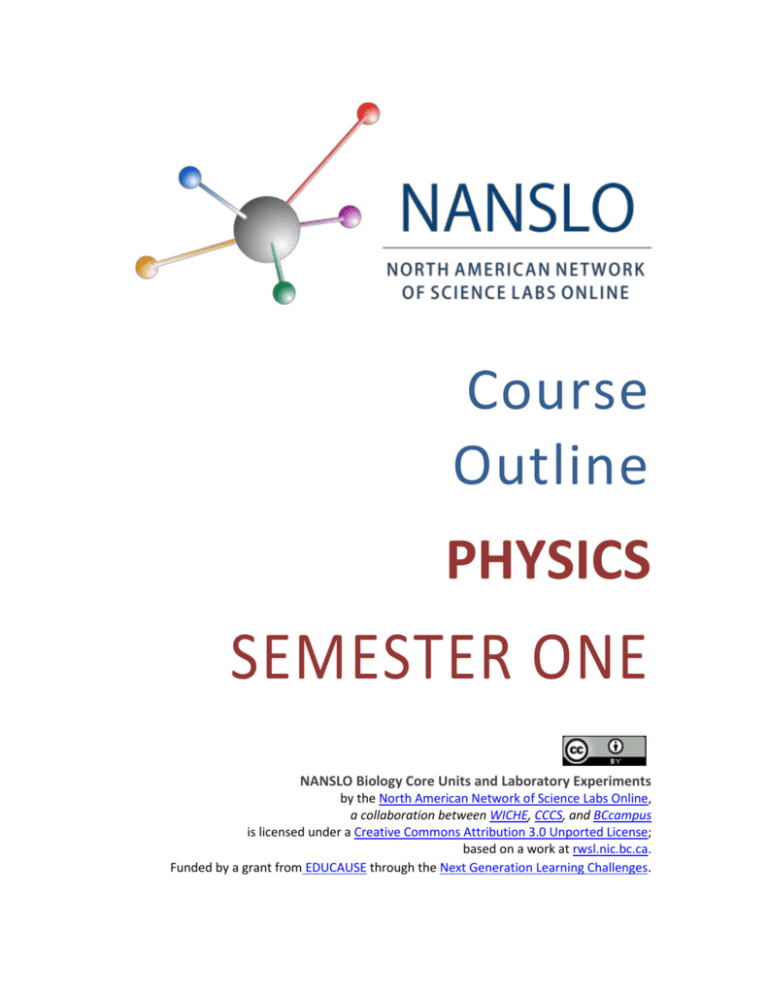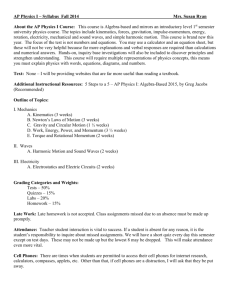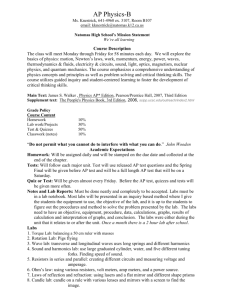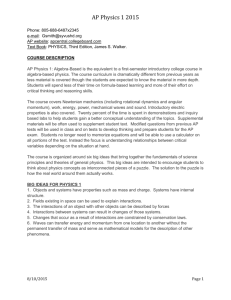Introduction
advertisement

Course Outline PHYSICS SEMESTER ONE NANSLO Biology Core Units and Laboratory Experiments by the North American Network of Science Labs Online, a collaboration between WICHE, CCCS, and BCcampus is licensed under a Creative Commons Attribution 3.0 Unported License; based on a work at rwsl.nic.bc.ca. Funded by a grant from EDUCAUSE through the Next Generation Learning Challenges. PHYSICS SEMESTER ONE COURSE OUTLINE SEMESTER 1 PHYSICS: COURSE OUTLINE Welcome to the Principles of Physics I course. Principles of Physics I is a one-semester, first-year calculus based course. This course is designed for students pursuing a degree in the sciences; possibly a career in the physical sciences. Principles of Physics I includes the study of: Kinematics (in one- and two dimensions), Dynamics, Work and Energy, Momentum, Rotation and Equilibrium, Oscillations, Waves and Sound, and Thermal Physics. You may also study from a variety of additional topics as assigned by your instructor. Course Purpose This course is designed to help students develop their understanding of several of the fundamental laws and principles in Physics. Principles of Physics I also gives students an excellent platform to hone their calculus and problem solving skills. The topics cover physical analysis of common phenomenon, like projectile motion and the propagation of sound. The laboratory portion of the course is designed to illustrate theoretical concepts and develop laboratory skills. Mathematical options in first-year Physics curriculum Although the NANSLO Physics course can be adapted to non-calculus based delivery, it will be developed with an expectation that calculus will be used to develop some of the theoretical concepts and will be required to complete homework and explain some experimental results. We note that "Calculus-Based Physics" is a somewhat general term & requires clear definition so that students are informed about the level of mathematical preparation required in the course & "receiving institutions" are informed about the student applicant's ability to use mathematics in more advanced courses. First-year undergraduate Physics courses may be categorized mathematically in the following way: 1. No calculus required. This type of course requires a relatively strong background in secondary school algebra but does not require calculus to understand the theory, conduct laboratory experimentation or write-up, or complete homework assignments. 2. Awareness/exposure/rudimentary understanding of calculus required. This type of course requires that the student is aware of what calculus can do and understands mathematical representations such as v=dx/dt and a=dv/dt. However, other key relationships (such as W=F(Delta x) will be presented primarily in an algebra-based form. 3. Understand concepts and results using calculus. In this type of course, calculus is used extensively to derive results in class, but students are not required to actually *use* calculus to do much more than take dx/dt to get v. A basic understanding of differential calculus is expected. 4. Use calculus independently to solve problems. In this type of course, calculus is infused throughout and used extensively in all types of assessments (homework, quizzes, exams). Ability to apply both integral and differential calculus is expected. We expect to incorporate a level of calculus at the 3.0 – 3.5 level in this NANSLO Physics course. Creative Commons Attribution 3.0 Unported License 2 PHYSICS SEMESTER ONE COURSE OUTLINE COURSE MATERIALS Student Manual and Course Notes. Text: o Physics for Scientists and Engineers, 8th edition, by Serway and Jewett o Fundamentals of Physics, 8th Edition, Halliday, Resnick, Walker; Wiley. or Laboratory Manual. Principles of Physics I Lab Kit ASSESSMENT (SUGGESTED) Assignments and Quizzes Laboratories Midterm Final (Comprehensive) 20% 20% 20% 40% Total 100% For any work you submit for assessment, be sure to show your work. Keep in mind that most of the marks for a multi-mark problem in assignments and exams is allotted for the work that leads to your final answer. The general problem solving method in which you define variables, state the equations, solve and then state the solution with appropriate units and significant figures is outlined in the Communicating Physics lecture notes. A sample lab report is included in the Laboratory Manual. Creative Commons Attribution 3.0 Unported License 3 PHYSICS SEMESTER ONE COURSE OUTLINE SCHEDULE The following table suggests a schedule/weighting of weeks for completing this course within a 15-16 week period. # of weeks Unit 1 Introduction 1 Kinematics in 1 Dimension 1 – 1.5 Kinematics in 2 Dimensions 1 – 1.5 Dynamics 1 Work and Energy 1 Momentum 1 **Midterm Exam** covers up to and including Momentum. 1 Rotation and Equilibrium 1–2 Oscillations, Waves and Sound 1 – 1.5 Thermal Physics 0.5 – 4 Optional topics 0.5 – 1 Review 0.5 – 1 **Final Exam** covers the entire course with emphasis on second half of the course. Creative Commons Attribution 3.0 Unported License 4 PHYSICS SEMESTER ONE COURSE OUTLINE SUGGESTED READINGS Unit Serway and Jewett Kinematics in 2 Dimensions sections 3.1–3.4 and 4.1–4.5; section 4.6 (interesting but not compulsory) Dynamics sections 5.1–5.8, 6.1–6.3 and 13.1– 13.3 and 13.5 Work and Energy sections 7.1–7.8 and 8.1–8.5; sections 13.6 (13.5 GPE on big scale, 13.6 satellite physics) are recommended but not required Momentum sections 9.1–9.6 Rotation and Equilibrium sections 10.1–10.9, 11.1–11.4, and 12.1–12.3 Oscillations, Waves and Sound sections 15.1–15.5, 16.1–16.5 (in 16.5 focus on equation 16.21 and the following paragraph, not the derivation), 17.1–17.4, 18.1-18.5, and 18.7 Thermal Physics sections 19.1–19.4, 20.1–20.3 and 20.5; section 20.7 (energy transfer) is interesting but not compulsory Optional topics As assigned Creative Commons Attribution 3.0 Unported License Halliday, Resnick, Walker 5 PHYSICS SEMESTER ONE COURSE OUTLINE STUDENT PROGRESS CHART You can expect to invest between 10 and 15 hours per week on this course, with the time divided roughly like this: 3 and 4 hours per week learning the new material (with the lecture notes provided or other source), an average of about 2 hours per week performing the labs 5 to 10 hours per week working on assignments, labs and textbook problems This is a considerable chunk of time so it is important that you make that you plan your available time carefully. The Student Progress Chart (below) should help you plan realistically. Student Progress Chart Week Unit(s) Reading assignment Problem assignment(s) Lab 1. 2. 3. 4. 5. 6. 7. 8. 9. 10. 11. 12. 13. Creative Commons Attribution 3.0 Unported License 6 PHYSICS SEMESTER ONE COURSE OUTLINE COURSE UNITS Introduction The course starts with a general welcome to the course, information about organization & online delivery, review of any of the optional topics required for the specific learner audience, explanation of the level of math used in this course (note that this course is calculus-based). Additional topics may include: dimensional analysis, system of units, uncertainty, significant figures, scientific notation, coordinate systems, solving problems with a mathematical approach, communicating scientific results Learning Objectives The student is expected to be proficient in the following topics: (for some, this may be a review): unit/dimension analysis, standard units, unit conversion, an introduction to error analysis, scientific, notation, significant digits, problem solving, and order of magnitude calculations. Assignments: Assignment #1 Laboratories: Lab #1 Measurement and Experimental Error 1D Kinematics Kinematics is the study of motion of an object without regard for the cause of the motion. The analysis is limited to the wide range of cases where the object in motion has zero or constant acceleration. Learning Objectives The student is expected to become proficient in the following topics. kinematics in 1 dimension: frame of reference, distance, displacement, speed (average speed, instantaneous speed), velocity (average velocity, instantaneous velocity), acceleration (average acceleration, instantaneous acceleration), position-time graph, velocity-time graph, acceleration-time graph kinematics problems in 1 dimension: variable definitions, equations relating kinematics variables, problems Assignments: Assignment #2 Laboratories: Lab #2 One Dimensional Motion Vectors and 2D Kinematics The two dimensional kinematics is preceded by a section on Vectors (properties with both size and direction) and Scalars (properties with just size). All physical properties within the course are expressed as either vector (displacement, velocity, momentum) or scalar values (mass, time, speed). Mathematical operations with scalars are just like working with numbers. Adding, subtracting and, later, multiplying vectors is more complicated. It is very important that you that you become skilled at working with vectors as they are used throughout the course. This Creative Commons Attribution 3.0 Unported License 7 PHYSICS SEMESTER ONE COURSE OUTLINE section extends the one dimensional kinematics principles with applications to special cases like projectile motion and introduces circular motion. Learning Objectives The student is expected to become proficient in the following topics. vectors: coordinate systems, vector addition and subtraction, multiplying a vector by a scalar, vector components, conversion between magnitude-direction form and component form of a vector motion in 2 dimensions: velocity, displacement and acceleration in 2 dimensions, scalar (dot) product of vectors, application of 1D relationships to vector components, projectile motion, circular motion, radial and tangential acceleration, discussion of motion in an accelerated reference frame Assignments: Assignment #3 Laboratories: there are no 2D Kinematics labs Dynamics Dynamics looks at the interaction of forces that actually causes the acceleration of an object. In both kinematics and dynamics, we will limit ourselves to motion in one or two dimensions. The two dimensional analysis can be readily extended to three dimensions. Learning Objectives The student is expected to become proficient in the following topics. force, Newton’s laws of motion and gravitation, normal force, friction, equilibrium, free body diagrams (FBDs), dynamics problem solving Assignments: Assignment #4 Laboratories: Lab #3 Resolving Forces Work and Energy Energy comes in many forms but we will initially limit the study to the kinetic energy of moving objects, gravitational potential energy and elastic potential energy, along with the concept of mechanical work. Conservation of Energy, where the total mechanical energy of a system is unchanged unless work done on system, is an important tool in solving otherwise difficult dynamics questions. Learning Objectives The student is expected to become proficient in the following topics. work, energy, scalar (dot) product of vectors, work done by varying force, kinetic energy, work-kinetic energy theorem, potential energy (gravitational, elastic), conservation of energy, changes in mechanical energy, non-conservative forces, power Assignments: Assignment #5 Creative Commons Attribution 3.0 Unported License 8 PHYSICS SEMESTER ONE COURSE OUTLINE Laboratories: Lab #4 Conservation of Energy Momentum Momentum is the product of an object’s mass and velocity. Momentum is another important quality that is conserved. Conservation of Momentum is often used to analyse collisions. Learning Objectives The student is expected to become proficient in the following topics. momentum, conservation of momentum, impulse, 1D collisions (elastic, inelastic), 2D collisions, systems of particles, centre of mass Assignments: Assignment #6 Laboratories: Lab #5 Conservation of Momentum Rotational Motion and Equilibrium. Rotational Motion is very similar to one dimensional motion. Many of the concepts used in one dimensional motion (displacement, speed, acceleration, force, kinetic energy, mass and momentum) have equivalent terms in rotational motion (angle, angular speed, angular acceleration, torque, rotational kinetic energy, moment of inertia, and angular momentum). The study of Equilibrium is similar to the study of Dynamics. Where the Dynamics section assumes forces on an object act on a single point, Equilibrium includes the location of the forces in the analysis. Learning Objectives The student is expected to become proficient in the following topics. rotation, angular speed, moment of inertia, torque, angular acceleration, rotational kinetic energy, vector (cross) product of vectors, angular momentum, conservation of angular momentum, static equilibrium Assignments: Assignment #7 Laboratories: Lab #6 Torque and Rotational Equilibrium Oscillations, Waves and Sound Oscillations, Waves and Sound covers at the properties of oscillatory motion. This section looks at the properties of objects under simple harmonic motion, waves, resonance, and the behaviour of sound. Oscillations, Waves and Sound is also an introduction to the concept of interference which is visited again in the Wave Optics section of Principles of Physics II. Learning Objectives The student is expected to become proficient in the following topics. Creative Commons Attribution 3.0 Unported License 9 PHYSICS SEMESTER ONE COURSE OUTLINE oscillatory motion: Hooke’s law, elastic potential energy, simple harmonic motion, waves (position, velocity and acceleration), pendulum motion, circular motion waves: frequency, amplitude, wavelength, wave speed, energy sound: sound waves, speed of sound, Doppler effect, energy and intensity of sound waves, spherical waves interference: interference of waves, standing waves, beats, forced vibration and resonance Assignments: Assignment #9 Laboratories: Lab #7 The Simple Pendulum Lab #8 Oscilloscope and Speed of Sound Thermal Physics Thermal Physics deals with heat and temperature. This section examines the changes of volume with temperature, changes of temperature/state with when energy is added to/removed from the system in the form of heat, and flow of energy (heat) through materials. Learning Objectives The student is expected to become proficient in the following topics. thermal equilibrium, 0th law of thermodynamics, temperature, thermal expansion, heat, internal energy, 1st law of thermodynamics, specific heat, calorimetry, latent heat, calorimetry with latent heat energy transfer mechanisms: conduction (thermal conductivity, R-values), convection, absorption/emission Assignments: Assignment 10 Laboratories: there is no lab for this section Other topics EXAMS There is one midterm exam covering Kinematics, Dynamics, Energy and Momentum. The final exam covers the entire course with emphasis placed on Rotational Motion and Equilibrium, Material Physics, Oscillations, Waves and Sound, and Thermal Physics. The exams are generally a set of problems that the student must solve. Marks are awarded for the student’s problem solving process as well as the final answer. The final answer should be expressed in with the appropriate number of significant digits, units and scientific notation when necessary. Creative Commons Attribution 3.0 Unported License 10 PHYSICS SEMESTER ONE COURSE OUTLINE Formula sheets are provided with the exams. Graphing calculators are not allowed on the exams. As this is a distance course, it is up to you to find an invigilator for your exams. Most colleges and universities offer invigilation services at a cost to you. You can also get your exams invigilated outside of a college or university if the invigilator is approved by the institution delivering this course. Contact your instructor for guidelines for invigilators. ABOUT THE LABS The laboratory work is designed to illustrate theoretical concepts, and develop laboratory skills and techniques. As this is a distance course, the labs are divided into those that can be done safely and effectively at home, and those that will be done on-line in our interactive web-based laboratory. At the time this was written, there are four home labs and four web-based labs designed for the course. Each of the web-based labs is only available during a fixed set of dates. You must schedule the time and date when you want to perform your experiment within the dates when it is available. Please see Lab Manual for other notes on the laboratories CONTACTING YOUR INSTRUCTOR Though it is probably easiest and fastest to communicate with your instructor via e-mail, but feel free to phone, fax and mail information to her/him. Labs reports should be created using a word processor with the files e-mailed. If you have access to a scanner, it is recommended that you scan your assignments (and if necessary, your labs), and then e-mail the file to your instructor. E-mailing files is probably the fastest way to get feedback on your work, though a phone call may be faster for simple questions. Exams must be mailed. Instructor: E-mail: Phone: Fax: Address: ............................................... .............................................. .............................. .............................. ......................................................... ............................................................. ............................................................. ADVICE THAT WILL HELP YOU COMPLETE THE COURSE This course is set up somewhat like a regular first-year physics course with a set of lecture notes, labs, assignments and exams. The suggested course schedule shows the approximate pacing of the course as it is taught in a classroom setting. However, because this is a distance-delivered course, you have somewhat more flexibility in the rate at which you proceed through the Creative Commons Attribution 3.0 Unported License 11 PHYSICS SEMESTER ONE COURSE OUTLINE material. It is strongly suggested that you set aside time each week for the course, just as you would if you were attending scheduled lectures and labs. The lecture material should not be used as your sole source of information for any particular topic. Read the text, or search for more information about the topic online. Check out the excellent MIT Open Courseware videos on the subject (http://ocw.mit.edu/OcwWeb/Physics/801Physics-IFall1999/VideoLectures/). There are many other excellent sources of information available and many ways to explain each topic. Find ones that you understand. Finally, don’t be afraid to ask your instructor/professor questions. This course presents several concepts to explain how objects behave in our world. The systems and problems are often simplified (utilizing perfect springs ignoring air resistance …) to better express the fundamentals of the concepts. Once mastered, these fundamental concepts form the basis upon which more complicated ones can be built. Examples: Kinematics and Dynamics often ignore air resistance and friction between surfaces in contact. Both are forms of friction that can be added to the basic equations describing the motion. In the case of friction due to contact, we can calculate the friction force from its relationship with the normal force. Air resistance, is usually described as force that is proportional to the square of the velocity. Inclusion of the air resistance in problems, where the velocity is not constant, requires mathematics that is beyond this course. In Kinematics, Dynamics, Energy and Momentum, we treat items as if their masses are concentrated at single points. All forces acting on an object are treated as acting on the single point. The kinetic energy and momentum of an object are calculated with the assumption that the entire object is moving at a single velocity. In Rotation and Equilibrium, we expand this to a more realistic case where forces are applied at different places on the object and different parts of the object can have different velocities due to rotation. Rotation and Equilibrium also includes the concept of the centre of mass; showing that an object can be treated as though all of its mass is located at the centre of mass for some analyses. The original relations for Kinematics still apply to the centre of mass, while the Dynamics, Energy and Momentum have new terms due to the rotational motion that are added to the original terms that apply to the centre of mass. The fact that the concepts, once developed, can be extended to more complicated concepts has more to do with the level of detail required than the need for a new theory. The basic concepts are still valid. Get in habit of using proper problem solving techniques. This may seem like extra work for easy questions but the habit will help immensely in the long run when you have to solve complex problems. The bulk of assignment and exam questions require problem solving skills. The acts of reading and understanding a question, breaking the problem down to simpler parts, recognizing which physical concepts are involved, and finding a solution are all important skills. These problem solving skills apply to all sorts of problems within and outside of physics. These Creative Commons Attribution 3.0 Unported License 12 PHYSICS SEMESTER ONE COURSE OUTLINE skills will help you solve problems throughout not only your academic life, but your professional and personal life as well. Delay substituting values and use algebra as long as possible when solving problems. This reduces problems with round off error and you may find that certain unspecified terms get cancelled out. If you have to substitute values before the final solution, keep an extra significant figure or two (not eight) to reduce the risk of round off errors. The assignments and questions in the lecture notes should not be the only places in which you practice your physics problem solving. Try problems in the text. Most texts have answers to odd numbered questions and study guides with detailed answers. A list of suggested problems is not provided, but you should generally work through several of the problems at the end of each chapter or section. The low numbered problems are generally easiest, getting harder as the problem number increases. Start with some low numbers and work your way up. The labs delivered through the Remote Web-Based Laboratory (RWSL) are usually available only during specific periods. If you fail to complete a lab during its scheduled period contact your instructor. Some make up lab time may be available at the end of the course. Ask questions. If you don’t understand something, often the act of forming a question helps you with your answer. If not, the instructor or another person can provide an explanation. The learning management system used to organize your course probably offers a bulletin board or forum where you can post questions for your instructor and classmates. Answer bulletin board questions, too. Answering questions helps you organize your thoughts on a particular topic. Don’t be shy. You can even ask crazy or fun questions like “Why is the sky blue?” or “What would happen if ...”. Science is built on people who ask questions and search for solutions. Talk to people. The fact that you are working on your own doesn’t mean that you’re isolated from your classmates and friends with some physics expertise. Discuss what you are learning. Make suggestions for improvements (point out my typos). Online forums and bulletin boards are excellent places to share ideas. ACKNOWLEDGEMENTS The lecture notes for this course were adapted from lecture-based course notes. The course was based on the textbook Physics for Scientists and Engineers, 7th edition (2008), by Serway and Jewett. Although there are several “classic” physics problems and examples, a concerted effort was made to make the tone of the lecture notes, examples and problems unique. In this way, the lecture notes complement instead of duplicate the textbook. This also renders the notes adaptable to other textbooks. The lecture notes have several links to Java applets from the University of Colorado’s Physics Education Technology website, http://phet.colorado.edu/index.php. These applets provide very detailed simulations of physical processes. I strongly recommend that you check these out and play with the different variables for the simulations. Creative Commons Attribution 3.0 Unported License 13 PHYSICS SEMESTER ONE COURSE OUTLINE th The labs and lab manual are based strongly on the 5 Edition of the North Island College Physics 100/101/120/121 Laboratory Manual, edited by Jason Diemer, and North Island College Physics 060 Laboratory Manual, On-line Edition by Dennis Lightfoot and Ron Evans. Feedback about the distance course program and general feedback was provided by Ron Evans. Tak Sato at Kwantlen Polytechnic University did a thorough job reviewing the notes and labs, and provided excellent suggestions on both fronts. The technical wizardry in making the webbased courses and labs functional was done by Albert Balbon and Mike Valmorbida at NIC. Rick Nowell at the College of the Rockies provided several very useful technical suggestions for the labs. Patricia Davies did the editing and formatting work that makes this material presentable. I also want to acknowledge Jason Diemer and Helena Higgs for their course supervision for my lecture courses and overall help with physics at NIC. Creative Commons Attribution 3.0 Unported License 14







